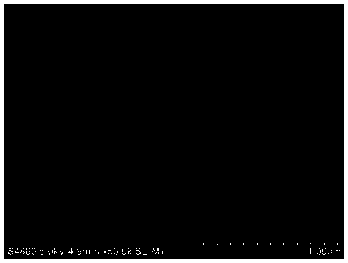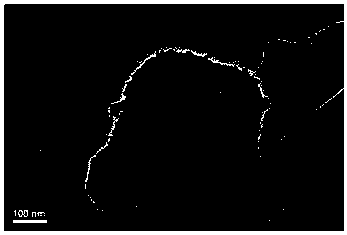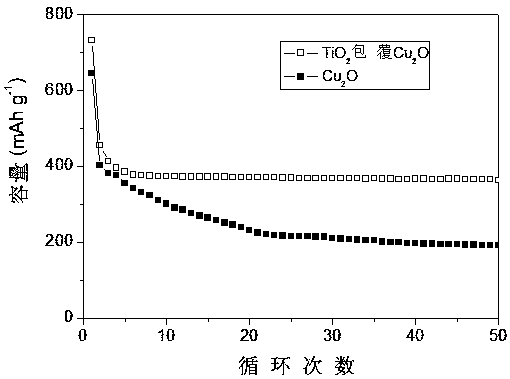Lithium ion battery negative electrode material and preparation method thereof
A technology for lithium-ion batteries and negative electrode materials, applied in battery electrodes, secondary batteries, nanotechnology for materials and surface science, etc., can solve the problem of limited improvement of cycle stability, failure to solve the problem of copper oxide volume expansion and Shrinkage and internal stress and other issues, to achieve excellent cycle stability, great commercial application prospects, and improve cycle stability
- Summary
- Abstract
- Description
- Claims
- Application Information
AI Technical Summary
Problems solved by technology
Method used
Image
Examples
Embodiment 1
[0028] Copper sulfate (CuSO 4 ), trisodium citrate and polyvinylpyrrolidone (PVP) were successively dissolved in deionized water, stirred to form a uniform aqueous solution, CuSO 4 Concentration 0.19 g L -1 , trisodium citrate concentration 0.6 g L -1 , PVP concentration 20 g L -1. Take 150mL solution, under stirring condition, add NaOH aqueous solution (concentration 40 g L -1 ) 20 mL, after reacting for 30 min, add dropwise 10 mL of ascorbic acid solution (concentration 105 g L -1 ), stirred for 15 min, stopped stirring, and stood still for 10 h. After centrifugation, the product was washed with deionized water and absolute ethanol several times, and stored in absolute ethanol.
[0029] Take Cu 2 50 mL of absolute ethanol solution of O (concentration 2 g L -1 ), add deionized water, stir evenly, then slowly add 0.1 mL isopropyl titanate drop by drop, stir for 3 h, centrifuge and wash the product with deionized water and absolute ethanol several times, and vacuum-dry a...
Embodiment 2
[0035] Copper sulfate (CuSO 4 ), trisodium citrate and polyvinylpyrrolidone (PVP) were successively dissolved in deionized water, stirred to form a uniform aqueous solution, CuSO 4 Concentration 0.38g L -1 , trisodium citrate concentration 1.2 g L -1 , PVP concentration 30 g L -1 . Take 150mL solution, under stirring condition, add NaOH aqueous solution (concentration 40 g L -1 ) 40 mL, after 30 min of reaction, 20 mL of ascorbic acid solution (concentration 105 g L -1 ), stirred for 30 min, stopped stirring, and stood still for 15 h. After centrifugation, the product was washed with deionized water and absolute ethanol several times, and stored in absolute ethanol.
[0036] Take Cu 2 50 mL of absolute ethanol solution of O (concentration 2 g L -1 ), add deionized water, stir evenly, then slowly add 0.2 mL isopropyl titanate dropwise, stir for 3 h, centrifuge and wash the product with deionized water and absolute ethanol for several times, and vacuum dry at 70 °C. get ...
Embodiment 3
[0040] Copper sulfate (CuSO 4 ), trisodium citrate and polyvinylpyrrolidone (PVP) were successively dissolved in deionized water, stirred to form a uniform aqueous solution, CuSO 4 Concentration 0.76g L -1 , trisodium citrate concentration 2.4 g L -1 , PVP concentration 30 g L -1 . Take 150mL solution, under stirring condition, add NaOH aqueous solution (concentration 40 g L -1 ) 80 mL, after reacting for 30 min, add dropwise 40 mL of ascorbic acid solution (concentration 105 g L -1 ), stirred for 30 min, stopped stirring, and stood still for 15 h. After centrifugation, the product was washed with deionized water and absolute ethanol several times, and stored in absolute ethanol.
[0041] Take Cu 2 50 mL of absolute ethanol solution of O (concentration 2 g L -1 ), add deionized water, stir evenly, then slowly add 0.2 mL isopropyl titanate dropwise, stir for 3 h, centrifuge and wash the product with deionized water and absolute ethanol for several times, and vacuum dry a...
PUM
| Property | Measurement | Unit |
|---|---|---|
| Size | aaaaa | aaaaa |
Abstract
Description
Claims
Application Information
 Login to View More
Login to View More - R&D
- Intellectual Property
- Life Sciences
- Materials
- Tech Scout
- Unparalleled Data Quality
- Higher Quality Content
- 60% Fewer Hallucinations
Browse by: Latest US Patents, China's latest patents, Technical Efficacy Thesaurus, Application Domain, Technology Topic, Popular Technical Reports.
© 2025 PatSnap. All rights reserved.Legal|Privacy policy|Modern Slavery Act Transparency Statement|Sitemap|About US| Contact US: help@patsnap.com



